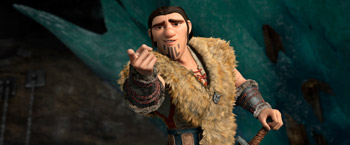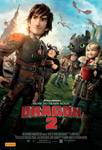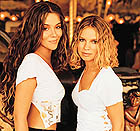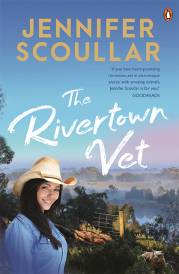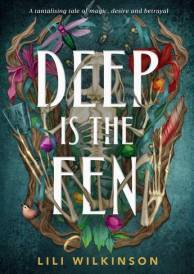Jay Baruchel How To Train Your Dragon 2
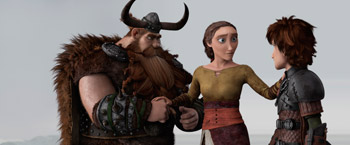
Jay Baruchel How To Train Your Dragon 2
Cast: Jay Baruchel, Cate Blanchett, Gerard Butler
Director: Dean DeBlois
Genre: Animation, Action, Adventure
Rated: PG
Running Time: 102 minutes
Synopsis: From DreamWorks Animation, the studio that brought you 'Shrek," 'Kung Fu Panda" and 'The Croods," comes the highly anticipated sequel to the Academy Award®-nominated How To Train Your Dragon, based on the children's book series by Cressida Cowell. In the thrilling second chapter of the epic trilogy, five years have passed since the heroic young Viking Hiccup (Jay Baruchel) befriended an injured dragon and forever changed the way the residents of Berk interact with the fire-breathers. Now, Vikings and dragons live side-by-side in peace on the fantastical isle that has been transformed into a dragon's paradise.
But when grown-up responsibilities loom on the horizon, Hiccup and his faithful dragon Toothless take to the skies in search of answers. It's much more than he bargained for, though, when Hiccup discovers that a mysterious dragon rider is really his long-lost mother Valka (Academy Award®-winning actress Cate Blanchett) and that the peace between dragons and Vikings is threatened by the power-hungry Drago (Academy Award-nominated actor Djimon Hounsou) with help from the dragon trapper Eret, son of Eret ('Game of Thrones" actor Kit Harington).
How To Train Your Dragon 2
Release Date: June 19th, 2014
About The Production
What A Difference Five Years Makes
In 2010, DreamWorks Animation's How To Train Your Dragon soared into theaters and stole the hearts of audiences around the world with its blend of high-flying action, witty humour and dramatic depth, earning $495 million in worldwide box-office receipts and nabbing two Academy Award nominations along the way, for best animated feature and best original score.
But the success of the film, written and directed by Dean DeBlois and Chris Sanders, was gradual. Even though it was a critics' darling from the get-go and No. 1 at the box office in its opening weekend, 'It actually underperformed according to studio expectations," Dean DeBlois says. 'But it had amazing legs. It clung at or near the top of the box office for seven weeks. We were all really proud of the fact that the word of mouth surrounding the movie was bringing audiences to see it, and bit by bit, we ended up surpassing studio expectations."
The triumph of How To Train Your Dragon spawned a TV series, a live stage show, a bevy of DRAGON merchandise " and legions of loyal fans.
'It's deeply satisfying to know that the passion we put into the film is reciprocated," Dean DeBlois adds. 'We see so much love coming back to us " fan videos and fan fiction and character drawings " it exists in a bigger way than we ever intended it to be."
From the beginning, DreamWorks Animation executives viewed DRAGON as a potential franchise. Its stellar reception and box-office achievement easily put sequel plans in motion. Since Sanders was turning his attention to directing DreamWorks Animation's 'The Croods," they approached Dean DeBlois about helming How To Train Your Dragon 2 on his own, with Sanders taking on an executive producer role.
'I told them, -I'm really interested if you'll entertain the idea of it being a trilogy,'" Dean DeBlois recalls. '-The first movie can serve as the first act, this'll be the larger second act and then there must be a third culminating act.' Thankfully, they bought into that concept."
'Dean DeBlois, in Hollywood terms, is the real deal," says Producer Bonnie Arnold. 'He's a great storyteller. He thinks like a little boy, which is always helpful when you're making movies about boys and their dragons. He's creative, but the best news is that he lets the other creative members of the team bring the best things they have to offer to the movie."
Agrees Visual Effects Supervisor David Walvoord: 'Working with Dean DeBlois is amazing. He's not just the director, but the writer, too. He has a incredibly special relationship with the characters and the world, and he has such a strong vision for what that world should be that it was really inspiring for us and, at the same time, made our job so much easier because he's really able to articulate what he's looking for, which helps send us in the right direction."
The first film, based on the children's books written by British author Cressida Cowell, introduced to audiences the gangly teenage Viking Hiccup, whose world is flipped upside down when he encounters and befriends an injured dragon he names Toothless. According to Bonnie Arnold, Dean DeBlois viewed How To Train Your Dragon 2 as Hiccup's coming of age story, 'not the -further adventures' of Hiccup and Toothless" as some sequels are prone to do. 'When Dean DeBlois pitched his idea for the second film to DreamWorks Animation executives, another crucial element of his pitch was the fact he wanted to age the characters by five years," she adds. 'It just made it a more interesting place to go and was something different that you don't see in animation, honestly. That was a bold choice on his part and we feel really grateful that DreamWorks supported that idea."
Not that it was always an easy choice.
According to Dean DeBlois, it was a bit of a challenge on the design front and a trial-and error process for the artists to retain the charm and appeal of each character while at the same time aging them.
'We discovered ultimately, with most of the cast, that if we could just retain their overall silhouette and stamp, but increase their size, change their wardrobe, age their face in subtle ways and give them different hairstyles, that seemed to do it," he says. 'Hiccup was maybe the trickiest one just because in aging him, we wanted to make sure that he didn't become a classic Hollywood hero. He had to retain his gangly quality, because there's so much of his charm in that, that dorky awkwardness that he possesses.
'So we made sure that even though he did get taller, he never quite filled out the way his father, tribal chief Stoick the Vast, had hoped he might in the first movie," Dean DeBlois continues. 'He's still slight of build but he continues to compensate with his intelligence, wit and advanced thinking."
Returning as Hiccup is actor Jay Baruchel, who personifies those very qualities, according to Dean DeBlois.
'I can't think of anyone else who could ever play Hiccup in this way, because the character is Jay Baruchel, to a large degree," he says. 'He embodies so much of what Hiccup is: A guy who's quick-witted, intelligent, spry on his feet…there's an adorable awkward quality to him that he's very aware of and plays to his advantage."
And it's through Jay Baruchel's ability to convey Hiccup's emotions that the audience connects with the character, says Bonnie Arnold.
'The audience is experiencing the movie through Hiccup. What makes the whole experience of the movie even more rewarding is understanding how Hiccup feels about a given situation," she says. 'Jay Baruchel is so passionate about the character and brings so much of that into his voice performance. As much as Dean DeBlois is a great writer of the Hiccup dialogue " and he really is " Jay Baruchel knows Hiccup better than anybody."
Dean DeBlois is quick to agree. 'Jay Baruchel often makes modifications to his own dialogue because he knows the character so well," he says.
Thanks to Hiccup's efforts in the first film, in How To Train Your Dragon 2, the residents of Berk, who once viewed dragons as a scourge to be eliminated, now live alongside (and ride!) them in friendship. This time around, they face a different kind of dragon problem, albeit a good one: There's so many of them! With everyone owning his or her own personal dragon and dragons permeating their way of life, the isle of Berk is a vastly different place.
To accommodate the new inhabitants, an abundance of modifications have been made on the island so that life is a little less dangerous for everybody: An aqueduct system is in place for putting out fires in a hurry; all-you-can-eat feeding stations mean no dragon ever goes hungry; caves have been repurposed into custom stables; a one-stop-shop dragon armory provides for all kinds of needs.
'The armory used to be the old blacksmith stall where Hiccup, in the first film, learned to be an apprentice," says Dean DeBlois. 'Anything can be taken care of there " whether a dragon has a toothache or needs to be groomed."
Says Production Designer Pierre Olivier Vincent (affectionately known as P.O.V.), 'It's a much more joyful, decorative place now, and that's reflected in the many new colors we used when we were redesigning the village. In fact, the colors of the film's main dragons came into play when we reimagined it."
Keeping up with the demand at the dragon armory is Gobber, the village blacksmith and put upon right-hand man of Stoick the Vast. Always up for adventure, he's played once again by Craig Ferguson.
'Gobber is the guy who has to build all these things that make living with dragons less dangerous so he longs for the days of the past where they fought dragons instead of living with them peacefully. Craig plays that frustration very well," Dean DeBlois says.
Even though their relationships have changed, one thing hasn't: Vikings are still Vikings...and dragons are still dragons. The How To Train Your Dragon 2 team recognised that the citizens of Berk needed a new outlet for their natural aggressions, so they created…dragon racing!
With Vikings on the backs of dragons, 'Dragon racing is exhilarating as long as you're not a sheep, I suspect," says Jay Baruchel. That's because participants have to head around the island hunting for the marked animals, scoop them up and dump them in a basket. Each one is worth a point; the black sheep is worth 10. 'It's kind of like the Monte Carlo race of Berk," says DeBlois.
A dragon race also proved to be an excellent way for the filmmakers to introduce audiences to the new Berk.
The opening sequence of How To Train Your Dragon 2 is 'this kinetic, visceral obstacle race of a game that flies by all the new updates in Berk and introduces familiar characters from the first film with their personal dragons, five years into those relationships," Dean DeBlois says.
The tough and competitive Astrid (America Ferrera) streaks through the sky on the back of Stormfly the Deadly Nadder; quarrelsome twins Ruffnut (Kristen Wiig) and Tuffnut (T.J. Miller) straddle the two-headed Zippleback Belch & Barf; the timid and skittish Fishlegs (Christopher Mintz-Plasse) wobbles furiously on his Gronckle Meatlug, while the smug and cocky Snotlout (Jonah Hill) zooms by on Hookfang, his Monstrous Nightmare.
'It's meant to be very energetic, fun and reassuring for audiences familiar with the first film " everything they loved about Berk is bigger and better " and it helps set the stakes for the rest of the movie," Dean DeBlois says. 'You realise that because this place is such a Utopia, anything that threatens it is really bad news"…and there will be a threat…
Notably absent from the dragon race is Hiccup and Toothless. Instead, the inseparable duo are doing what they love best " taking to the skies in search of new dragons and new lands to add to Hiccup's ever-expanding map.
'In their spare time, not only have Hiccup and Toothless been pushing the limits of what's possible with flight, but they've been out there mapping the world, which has become their new hobby," Dean DeBlois says.
Adds Head of Story Tom Owens: 'They've taken that Viking map from the first movie and they've been addi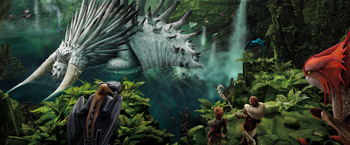 ng pieces onto it in every direction. Hiccup is just a curious and restless soul. He's always out looking for the next adventure."
ng pieces onto it in every direction. Hiccup is just a curious and restless soul. He's always out looking for the next adventure."
On this morning, taking flight into the vast unknown is also a way for Hiccup to blow off some steam: Before the start of the races, he's told by father Stoick that it's time for the young Viking to assume leadership of the island, a task that Hiccup isn't quite ready for.
'Stoick, who is a burly, brawny, gregarious mountain of a man, is incredibly proud of his son, despite his size, for what he has accomplished in bringing peace to Berk," says Gerard Butler, who portrays Stoick. 'Their relationship has changed for the better in the past five years. Hiccup used to be an embarrassment to Stoick but now he wants to make his son the island's next leader."
Unsure what his true purpose is, Hiccup can't imagine filling his father's large boots " literally and figuratively.
'With Hiccup, we've seen some of his promise in the first movie realised a bit here," Jay Baruchel says of his character, 'but the obligations of adulthood are starting to pile up. It doesn't take a math whiz to know that as the son of the chief, he's next in line, and he struggles with that."
While he may be seeking to find his purpose, he does know where his strengths lay and he has been putting his talents of ingenuity to good use by creating a variety of inspired tools.
'Hiccup and Toothless often come across hostile new dragons in these new lands they've discovered, and so Hiccup, being the advanced thinker that he is, built himself a tool that harnesses the power of dragon fire," Dean DeBlois says. 'It's a sword hilt with a collapsible blade, but inside of it are two cartridges: One contains the saliva of a Monstrous Nightmare, which is a sticky napalm-like fire. The blade comes out pre-coated in that saliva and a rudimentary lighter ignites it. To dragons, that's a very arresting image. It helps them see Hiccup as a dragon himself because he can produce his own fire. If Hiccup gets surrounded by a bunch of hostile dragons, he uses the back end of the sword, which contains a cartridge of highly flammable Hideous Zippleback gas in it: He sprays a ring around himself and ignites it, creating a flash explosion that gets their attention," Dean DeBlois says.
Adds Jay Baruchel: 'It's his light saber. It's really, really cool. He's also constructed my favorite thing in the new movie: This really wicked flying suit that not only keeps him warm and looks cool but is outfitted, on his forearms, with everything he needs on his aerial excursions. He's got a dagger, which he uses as a tool; extra paper for his expanding map; a pen and a rudimentary compass; and not only can he ride Toothless now, he can also fly side-by-side with him, which is pretty special."
'Dean DeBlois was instrumental in the design of Hiccup's outfit," says P.O.V. 'He really wanted Hiccup to have a suit that gave the sense that he had, in five years, perfected his understanding of dragons and had trained himself to behave like one " at least in the art of flying. Hiccup is a little bit of a Leonardo da Vinci in the Middle Ages."
The only other person who has contributed to Hiccup's map nearly as much as he has is the tough and spunky Astrid, who has become a fellow explorer " and more than just a friend.
'Astrid is Hiccup's girlfriend now," says America Ferrera, who returns to voice the courageous Viking maiden. 'She is Hiccup's No. 1 defender and champion. She's a leader in her own right. Their relationship is one of equals. When Hiccup goes off to an adventure, she's not sitting back hoping that he gets back safely."
'Although Astrid doesn't think the same way that Hiccup does, she knows him well enough that she's capable of prodding him into finding an answer he might not have been able to find on his own," says Tom Owens. 'She knows how to get the best out of him."
'I'm so thankful that America came back to play Astrid," Dean DeBlois says. 'She has such a strong, powerful voice and it comes through in the character with this spunky, up-for-anything quality. But also inherently in America's voice is a sense of reason and self-assuredness that the character of Astrid really represents to the story."
Astrid is right by Hiccup's side when he discovers a trapper's fort in the northern reaches of Norway, which has been blown to bits by what appears to be an enormous ice storm; all that remains are giant splinters of wood lodged in massive spikes of ice. As they fly closer, they encounter a ship and its motley crew, led by a brawny young dragon trapper. He's got a repetitive name, an over-sized ego and an eye for Toothless and Stormfly.
'Eret, son of Eret, who is one of three new characters in DRAGON 2, is a little bit full of himself. He claims to be the finest dragon trapper alive," says Dean DeBlois, 'because he and his team have been successfully trapping them for some time."
'Eret thinks that he knows more about dragons than anybody, but it turns out that he doesn't have an inkling how deep a connection to dragons can go," Tom Owens says.
In time, his opinion will change. 'There's more substance to him than Hiccup and Astrid give him credit for when they first meet him," Dean DeBlois says. 'Through their influence, Eret comes around to realizing that dragons aren't the commodity he has thought them to be; that they are loyal and if you take the time to earn their loyalty, they will do anything for you."
The filmmakers chose Kit Harington, the popular young British actor from HBO's 'Game of Thrones," to bring Eret, son of Eret, to life.
'Kit showed up on a short list of possible actors to voice Eret," says Dean DeBlois. 'I knew him from -Game of Thrones' and I can safely say he's my favorite character on that series. I thought he was perfect for the role."
Adds Bonnie Arnold: 'Eret is supposed to be about 20, the same age as Hiccup. We liked that Kit's voice was youthful, commanding and charming at the same time.
'-Game of Thrones' was just taking off when we met and it was serendipitous that he's gotten such a following in the years that we've been making the movie," she says.
Despite his abilities, Eret doesn't trap dragons for his own amusement. He works for Drago Bludvist, a vicious megalomaniac without conscience or mercy, who once claimed to be a man of the people, devoted to freeing mankind from the tyranny of dragons. In reality he presents an even bigger danger than Eret, who's just a middleman: Drago is building a dragon army.
'Drago Bludvist is a man whose reputation is well known across lands but for all the wrong reasons," says Gerard Butler. 'He's killed many Vikings. He puts the fear of God into Stoick. He knows from past experience what Drago is capable of."
Adds Tom Owens: 'Drago really doesn't like dragons, but he's a little bit like Hiccup in that he's figured out how to work with them " only in a negative way. He's like a dog trainer who trains attack dogs: He can make dragons bend to his will through fear and control."
To play the fierce character, the filmmakers turned to Academy Award- nominated actor Djimon Hounsou, a man who is known for portraying intense and often formidable roles to full effect.
'What a great, powerful voice he has," says Tom Owens. 'I watched Djimon record once. When he warmed up, he made all these loud, primal noises to get himself in the mood. He really took it to another level. When he recorded, he looked furious and got really sweaty from his exertion. It was very intense and so much fun to watch."
Standing in the way of Drago's quest to round up herds of dragons is a mysterious dragon rider who consistently rescues them from Eret's traps and hides them deep in the Arctic. As Hiccup searches for answers and gets deeper into the mystery, it's not long before he and Toothless come face-to-face with the dragon rider, who turns out to be someone Hiccup thought he would never meet: his mother. Taken by a dragon when Hiccup was just a baby, she's been missing for 20 years and presumed dead by the villagers of Berk.
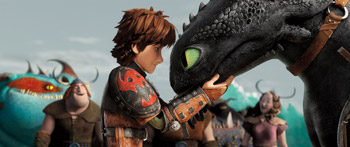 'It was never stated in the first movie that Hiccup's mother was actually dead; it was just implied," says Tom Owens. 'That gave us the open door to say, well, what if she wasn't dead?"
'It was never stated in the first movie that Hiccup's mother was actually dead; it was just implied," says Tom Owens. 'That gave us the open door to say, well, what if she wasn't dead?"
In How To Train Your Dragon 2, she's far from it. Valka is a dragon-whisperer who is accomplished in the ways of dragons and knows secrets about them that Hiccup hasn't even discovered yet.
Residing in Dragon Mountain, an epic ice formation with an amazing tropical oasis microclimate nestled inside in its core, 'She's been living like Dian Fossey with thousands of dragons all this time, learning their ways and becoming their fierce protector," Dean DeBlois says. It's a big moment in the film when Valka reveals to Hiccup the place she calls home.
'Right from the beginning, Dean DeBlois had a strong vision of what the Dragon Oasis was all about," says Head of Layout Gil Zimmerman. 'We knew it would be this surprising place where plant life could live in an arctic region that was big enough to support a whole bunch of dragons.
'From a cinematic standpoint we had to figure out how to reveal it to the audience, because it's a hugely impactful story point and we really wanted this visually stunning way to introduce it," he continues. 'So we went old-school: there's an old adage that if you're going go into a big, wide-open space, you start off in a very tight, confined space."
In the movie, as Valka introduces Hiccup to her world, she leads him through a dark, confined tunnel. As they approach the oasis, the first inkling the audience gets of the grandeur is a tight shot on Hiccup's stunned face. 'Then it's revealed to the audience how spectacular it is," Gil Zimmerman says.
'It's breathtaking, right? For us in lighting it was also the opportunity to convey that," says Head of Lighting Pablo Valle. 'You have to feel that moment's sense of awe, where the world opens up through Hiccup's eyes " he's seeing this and not believing what he's seeing because it's so vast and so beautiful. It was important for us to carry that idea.
'There are two things going on in this scene, each of which was fun to play with," Valle continues. 'Mother and child reconnecting after so many years on one level, and Hiccup's awareness that the world is much bigger than he ever imagined it to be on another."
In this improbably immense space, tropical ferns, free-flowing waterfalls and bubbling hot springs abound while thousands of dragons permeate the space.
'It was one of two seminal moments from the script " the other being the epic battle sequence " that we knew we needed to create something that was extra-special," Gil Zimmerman adds.
The questions Hiccup has for his mother! Meeting her is like finding an elusive, missing piece to a puzzle as he soon realises how similar he is to Valka.
'Hiccup knows that he's not a carbon copy of his father and feels a little uncomfortable knowing that there's this other part of his soul that pines for something more, that is most comfortable when he's out there with his dragon, searching for a purpose," Dean DeBlois says. 'So meeting his mother and knowing that she has this great purpose to her life is deeply meaningful for Hiccup, because he feels, in that moment, that he's found the missing half of his soul. He finally knows who he is."
The only challenge is that Valka and Hiccup have differing philosophies about human interaction with dragons. Valka doesn't believe co-existence is possible because 'she's seen too much of the evil ways of humans," according to Dean DeBlois. She thinks the only way to keep dragons safe is to hide them from humans. Hiccup, on the other hand, knows co-existence is possible not only because he has experienced it first-hand but also because he knows he can change minds and bring peace. That becomes the issue that they have to resolve, and ultimately it is Valka's arc in the story.
From the moment he conceived Valka as a character, Dean DeBlois knew whom he wanted for the part: Oscar®-winning actress Cate Blanchett.
'I wrote the character with Cate Blanchett in mind, not knowing whether she'd be interested at all," Dean DeBlois says. 'I just thought she was a perfect model. She has played characters in the past that have such a fiery strength and command to them.
'And then, when we were at the Academy Awards the year we were nominated for -Dragon,' I spotted Cate Blanchett mixing with people before the ceremony. I walked over and introduced myself. I told her, 'I wrote a part for you in How To Train Your Dragon 2, whether or not you're interested," Dean DeBlois laughs. 'She wanted to know more on the spot. So I told her a little bit about the character. She said, -Well, listen. My boys are huge fans of the first movie and we watch it a lot at our home and I'm not doing anything at the moment. Please send me the script.'"
'We were all very excited to have her on board," says Tom Owens. 'She's a powerhouse actress and has such emotional depth in her speaking voice."
There's an inevitable moment in How To Train Your Dragon 2 when Stoick and Valka are reunited after two decades. To fully appreciate the significance of the occasion, the filmmakers set out to make the scene a poignant one. After all, it isn't every day one encounters a loved one who has been presumed dead for 20 years.
'The scene where Stoick sees Valka for the first time is virtually unchanged from the first script," Dean DeBlois says. 'It has remained very pure: We wanted Stoick to be wordless " to be struck as though he's seeing a ghost " when he runs into her. Valka, meanwhile, has all this defensive babble to get out of the way because she knows that she made the wrong decision by not returning to her family and she's trying to justify it but she's just making herself fall apart. The whole time he's steadily approaching as though he can't believe what he's seeing. It ends in this beautiful single phrase from Stoick and a kiss and we let the audience know that all's been forgotten and forgiven as far as he's concerned. I love the idea we suggest " that Valka was Stoick's only love and that he never had any other interest."
'Stoick had resigned himself to life without Valka, and then suddenly, she's there," says Gerard Butler. 'For him, it's a change at something that he never thought would be possible anymore, to have his wife back, to have a mother for Hiccup and to be a family again. It's romantic, exhilarating and heartbreaking. He's a young man all over again, and he's so happy."
For Hiccup, too, seeing his parents together for the first time is momentous. In both of them he sees fiery, powerful, headstrong personalities " and finds his identity in understanding both of them.
'So many animated films take for granted that there's a parent " or maybe both parents " missing," Dean DeBlois says. 'We saw this as an opportunity to bring together a family that had been seemingly torn apart forever and to really feel that Hiccup's life had become complete before thrusting him into a new chapter of his life."
'I've never seen animated characters seem so complex and deep and have such an emotional reconnection," offers America Ferrera. 'You get to see Hiccup and his parents be a family at last. You get to see what could have been, had his mother and father not been torn apart."
Adding to the emotion of their reunion is Academy Award-nominated composer John Powell's sweeping score and a song he and Icelandic folk singer Jónsi wrote for Stoick and Valka, one of three pieces on which the musicians collaborated.
'Dean DeBlois wanted something that sounded like an old folk song that they could sing together," John Powell says, 'a melody that in the story had been their courting song long ago. So Jónsi and I sat down and started writing melodies and the arrangement. The tune became the theme music that represents Stoick and Valka's relationship in the film."
Adds Jónsi: 'John Powell and I both worked on DRAGON but this was the first time we collaborated on music together. Even though our styles are so different, I learned a lot from him and I'm really happy with this song and the result of all our work."
As the menace of Drago and his army of dragons continue to loom, the timing of the family reunion couldn't be better. It's an opportunity for Stoick, Hiccup and Valka to pull strength from their family unity and, along with their loyal friends, to band together to fight the looming threat…and it's a big one.
Meanwhile, those loyal friends are also the comic relief of How To Train Your Dragon 2 " particularly Ruffnut, who develops a crush on Eret, son of Eret, while simultaneously fending off two suitors of her own: Snotlout and Fishlegs.
'Kristen Wiig, who plays Ruffnut, does it so well," Dean DeBlois says of her constant rejection of the boys and her slavish fawning over Eret. 'She's the last of Berk's scarce and scary single ladies but she has no interest in either of them. We have some very strong female characters in Astrid and Valka. We thought there was room to have one that was completely shallow and vapid as well," he chuckles. 'We made Ruffnut as ridiculously shallow as possible. She's willing to throw everything she has at Eret to try to get his attention, just as Snotlout and Fishlegs are dying for hers."
This time around audiences get to see a different side of Jonah Hill: putting romantic charm into his character as Snotlout tries to gain the advantage over Fishlegs for Ruffnut's affections. But he really hasn't changed much.
'Snotlout is always trying to draw attention to himself, and he is always trying to impress," says Dean DeBlois. 'Of all the friends, Snotlout is the only one who hasn't actually grown much in five years, and so it adds to his overcompensating behavior."
'Snotlout strikes me as the type of guy that peaked in high school," says Tom Owens. 'He's always going to be at that level, mentally speaking. He's gotten older " he's got facial hair that he's really proud of " but he's still kind of a simple soul at heart."
Christopher Mintz-Plasse is back as Fishlegs, the big, loveable oaf who knows everything there is to know about dragons. 'We get to see a more aggressive side to him this time around because of his competition with Snotlout," Tom Owens adds.
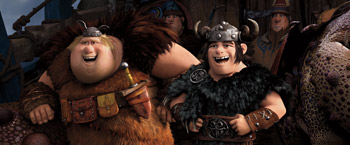 Ruffnut's antagonistic twin is played by T. J. Miller.
Ruffnut's antagonistic twin is played by T. J. Miller.
'T.J. Miller is one of the funniest people on Earth," Dean DeBlois says. 'He gives us all sorts of ad libs that I love to use whenever we can. I just can't get enough of the banter he has with Kristen Wiig as the battling twins " and they're always at war with each other. It's just kind of a silly, nonsensical joke. We love to play out the idea that even though they're forced to work together, they're always trying to sabotage each other."
A Whole New World Of... Dragons
In the first film, the 'Dragon" team introduced the idea that there's a dragon hierarchy " and that a monstrous Alpha dragon hidden away in a cave is served food by squadrons of other dragons or risk being devoured themselves. What if the Red Death of the first movie was actually not the top of the food chain? What if there were a couple of rungs above it and, at the very top, a behemoth of a dragon, bigger than anyone has ever seen?
'Heading into the second installment, I felt that was something we could expand upon," Dean DeBlois says. 'In How To Train Your Dragon 2, there are only a few Bewilderbeasts in existence but they are the natural-born Alpha of the dragon world. They have an unseen ability to communicate with, and force their will upon, other dragons " all except for the babies, who listen to no one," Dean DeBlois says. 'So, if you control the Alpha, you control all the dragons."
Drago's secret weapon is just such a beast, which he has trained to fight at his command. When he discovers that Valka is protecting a benevolent Bewilderbeast in her sanctuary, he sets in motion a plan to draw it out in an epic battle for dominance before moving on to pillage Berk and capture all of its dragons.
In creating the beast of all beasts, the filmmakers tasked themselves with challenging the notion of what a dragon is.
'The inspiration for the Bewilderbeast came from director Dean DeBlois," says Production Designer P.O.V. 'He said that he wanted to have a creature as powerful as a polar bear. That was the starting point. After that, we had to do a lot of work to, of course, turning a polar bear into some sort of a dragon, but you can still see, in the anatomy of the Bewilderbeast, that when he lifts himself up on his back leg, he has a little bit of the posture of a polar bear."
'When we broke too far away from the conventions, there were a lot of failed attempts at designing this creature," Dean DeBlois laughs. 'At one point, we had a wooly mammoth-looking dragon, but the moment that you put fur or hair on a dragon it just doesn't feel right anymore.
'We landed on this creature with the giant tusks, which were actually inspired by a wooly mammoth," he continues. 'The proportions of it were inspired by large Arctic muskoxs."
Interjects Jay Baruchel: 'They're massive and what's cool (no pun intended) is that they don't breathe fire " they breathe massive shards of ice."
'We decided that since a Bewilderbeast is a sea dragon, it ingests copious amounts of water and stores it in goiters in its neck," says Dean DeBlois. 'When needed, it regurgitates with such extreme force that it blasts apart its target, but because the breath is so intensely icy, it also freezes mid-blast, so you get these very interesting and alarming shapes that are created in the ice"…
…Which proved to be challenging to the visual effects team. 'Ice is extremely difficult to render, ," Visual Effects Supervisor David Walvoord says. 'It's not one of the things that we have down, like skin and hair. They're challenging, too, but we've done a lot of it. But ice! We had no idea what it should look like or how it should move. It took a lot of referencing and iterating different ideas to find something that was believable and that would, at the same time, give you a funky, weird sculpture when you were done. It also needed make a powerful visual statement."
As they face off in combat, the contrast between the two Bewilderbeasts is striking: Drago has trained his dragon to be an aggressive fighter and it wears many scars from earlier fights on its dark skin. Valka's Bewilderbeast, on the other hand, is a kind creature, bright white and 'quite magnificent," says P.O.V.
'The surfacing department did an amazing job in making sure that there is detail all over their skins," says Pablo Valle. In the larger-than-life battle sequence, 'The camera keeps cutting in closer and closer and you still get a sense of the scaly texture they're made of."
Effective lighting was crucial in helping to differentiate the two Bewilderbeasts, says Pablo Valle, especially when they are in the throes of warfare; it helps to contrast the good from the bad.
'You definitely don't want people confusing them," he says. 'They're the same type of dragon, but you want to be absolutely clear whose side each of them is on. The biggest challenge for us in lighting was their scale. They're each the size of a mountain. It's easy to either not convey that sense of scale or just let them get so massive that they overpower everything."
It was a challenge for other departments as well.
'Gil Zimmerman, our Head of Layout, spent a lot of time and effort trying to compose those shots to get that sense of drama and scale in all those characters," says P.O.V. 'It's quite complicated, because you have the human scale, you have the dragon scale and you have the very large dragon scale. It's not always easy to frame."
Declares Gil Zimmerman: 'The battle sequence is, in my experience, beyond anything that's been done in animation. It's more akin to what ILM or Weta does. It was certainly the most challenging for every department to have accomplished it, just because of its sheer size."
Supervising Editor John Carr enjoyed cutting the scene.
'The battle scene was fun to cut because when Stoick battles Drago, you also see the two Bewilderbeasts battling off in the distance, mirroring the Viking battle, each gaining the upper hand when their human counterparts do. So when Drago's Bewilderbeast is winning, Drago is winning; if Stoick is succeeding, so is Valka's Bewilderbeast."
Walvoord chimes in: 'There are shots in that battle that are extraordinary. There's an eight hundred or nine hundred-frame shot, flying over the battlefield right at the start of the scene. The coordination between camera, animation, crowds, lighting, effects, character effects, with nets coming and downing dragons that are flying by and you're flying over the heads of all these crowd guys, and the armies running, is just incredible and so much fun to watch.
'That whole battle has such a striking look," he continues. 'Everyone is used to animated films being colorful and happy and this is almost a black and white sequence. It's not quite, but it's very dark characters on white snow and we totally played up those silhouettes to try and get as powerful a graphic read as we could. Dean DeBlois wanted this really bright sequence that, at the same time, felt like a real battle. I think we pulled it off nicely."
In the chaos of battle, of course, are thousands of other dragons, including our hero dragon, Toothless, and some other familiar faces.
When asked why Toothless is so beloved by audiences, Gil Zimmerman cites the dragon's ability to connect with audiences.
'There are times where he is absolutely a puppy dog, other times when he's clearly a cat, other times he's something in between," he says. 'Toothless is an innocent character " as a dragon, he does have a certain amount of intelligence that's beyond a regular pet " but he has this supreme naïveté about him that makes him a beloved character. People see their own pets in Toothless. In response to that, we're always looking for good moments to bring the Toothless factor into a scene."
Producer Bonnie Arnold says audiences will appreciate the many types of dragons that show up in How To Train Your Dragon 2.
'They won't be let down when they see what we've got, both old and new. We were able to make the dragons that audiences knew from the first movie even more interesting by giving them proper names, more features and more defined personalities. There's closeness between the characters and their dragons as they work together. It's fun but it's also heroic and poignant at times."
Stoick has a brand new dragon, Skullcrusher, that wasn't seen in the first film. 'He's a big rhino of a dragon, mixed with a truffle pig," DeBlois laughs. 'He's a very eager but very serious tracking dragon and can find just about anything on scent. He's a bloodhound. We wanted a dragon that was sizeable so that when Stoick sits up on top of him, it feels like this thing could carry his weight " but also doesn't make Stoick look ridiculously small in the process."
Gerard Butler describes him this way: 'Skullcrusher is the dragon version of Stoick: He's prideful and doesn't suffer fools gladly. He's super powerful and strong and he's not going down anytime soon."
Valka's dragon Cloud Jumper, which exhibits a lot of owl behavior, is an amazing creature with two sets of wings that can split apart and makes for a very distinct silhouette in the sky. It also happens to be the same dragon that abducted her 20 years ago. Because of their long-term relationship, 'they have such an intuitive way of flying together that Valka doesn't even need a saddle," DeBlois says. 'She stands up on it and it barrel rolls and she walks around it."
Astrid's relationship with Stormfly the Deadly Nadder has evolved, much like the other riders and their dragons. 'They're five years in, they understand each other, and they reflect each other's personalities to some degree," Dean DeBlois says. 'Astrid is very headstrong and extremely capable. We gave Stormfly a personality that complements that by making her more like a doting fetch dog in the sense that she listens to Astrid's every command with great enthusiasm. So Stormfly does love to fetch whatever it is, whether a ball or a human! They have a really playful relationship, which is a nice outlet for Astrid because she's otherwise so serious and strong."
The twins Ruffnut and Tuffnut ride the same dragon, a two-headed Zippleback named Belch & Barf, each which have distinct personalities and are always at war with each other. 'We love playing out the idea that even though they're forced to work together, they're always trying to sabotage each other," Dean DeBlois says.
'Fishlegs and his Gronckle, Meatlug, are the loveable pair. Meatlug is Fishleg's steady and stalwart buddy. She gives off the appearance of being somewhat dimwitted, a quality that is reflected on Fishlegs. But you can't write Fishlegs off as a dullard because he's actually quite intelligent. She's there for him at all times…they just move at a slower pace," DeBlois says.
'Snotlout and his dragon, Hookfang, a Monstrous Nightmare, are the aggressive showmen. They're always trying to draw attention to themselves, always trying to impress. He's kind of like the little guy who drives the big expensive car just to make himself seem more impressive," Dean DeBlois laughs.
Gobber's dragon is Grump, a large, lazy, walrus of a dragon. 'He lives up to his name," Dean DeBlois says. 'He's always grumpy, always in theway, always falling asleep, all of which adds to Gobber's aggravation on a daily basis."
Of all the dragons in the film, there's only one, the Monstrous Nightmare, that looks like a 'traditional" dragon ('If you do a Google search on dragons, most of the time, you're going get some lizards with wings, basically," says P.O.V.) and that's intentional. 'We're creating dragons that have more personality," he says. 'For example, what do you get by mixing a bulldog and a dragon? You get a Gronckle. We found inspiration in the animal world, and not necessarily just reptiles. If we found a funny-looking bird that we were going to turn into a dragon, we'd perhaps keep some of its colors in the new creature."
When it came to creating the multitude of background dragons safely housed in Valka's sanctuary, the DRAGON team turned to its new technology (more on that in a minute), which allowed the artists to quickly multiply them.
And then there are the baby dragons.
'We call them Scuttle Claws and they're introduced in the Dragon Oasis, just as kind of manic little fire-starters everywhere they go," says Dean DeBlois. 'They're the only dragons that are not susceptible to the control of the Bewilderbeast, because they're too young and Hiccup actually uses that to his advantage a bit later in the movie."
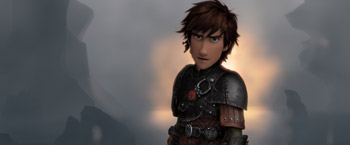 The Inspiration... The Art
The Inspiration... The Art
After the first DRAGON wrapped and before production began on the second film, Director Dean DeBlois, Producer Bonnie Arnold, Head of Layout Gil Zimmerman, Production Designer Pierre Olivier Vincent (P.O.V.), Supervising Animator Simon Otto and Supervising Editor John Carr took a trip to Norway to glean inspiration from the Nordic setting.
'We had talked about doing it for movie one, since the film was obviously loosely based on Viking culture, but it didn't happen," Bonnie Arnold says. 'Then we felt it would be a good time, before we started movie two, before Dean DeBlois even wrote the script, to take a trip to the Norwegian Folk Museum and the Viking Ship Museum in Oslo."
'The inspiration for me was most evident when we went to a fjord " just the sheer grandeur and spectacle of this big river with giant mountains coming out of the water as its banks," says Gil Zimmerman, who as head of layout, is to an animated film what a cinematographer is to a live-action one, responsible for the rough blocking of characters and cameras, working closely with the director and editor.
Offer Bonnie Arnold: 'It ended up being a little bit of a photo safari. We did a lot of research on Movie One, but things that we found there helped us to make Movie Two an even a better experience."
'My big takeaway from that trip is the way it solidified us as a team," Gil Zimmerman adds. 'We developed investment in each other's lives and learned how to communicate really well with each other. The challenges of this movie really required that we had something other than just a corporate relationships to draw from."
Making any film, animated or live action, necessitates a lot of teamwork. But one might argue that How To Train Your Dragon 2, with its epic scale and scope, requires even more teamwork, especially since it's much more like an original story, with many new sets. In fact, only one from the first DRAGON " the isle of Berk " has been reused for DRAGON 2.
'That's one of our most complex sets, so it did help us, especially early on," Gil Zimmerman says. 'One of the first scenes that we had to do was on Berk but because of Hiccup's explorations, there are a lot of different worlds now. The first thing I got involved with is scouting sets with our production designer, P.O. V.
'Having Dean DeBlois in the room with us deciding how we were going to stage things, what we needed to see, really gave us a sense of investment in the choices that we were making really early, as well as from a practical sense," he continues. 'He was with us in the mo-cap room, too, when we moved the virtual camera around on the set and chose where we were going stage various parts of the action."
One of the early stages in the production process is called pre-visualization, when the filmmakers fine-tune what scenes are going to look like. To achieve that on How To Train Your Dragon 2, the layout team relied heavily on motion capture technology as a tool (about 80 percent of the film's sequences went through the mo-cap room), which gave the filmmakers creative control of the camera and allowed them to stage scenes in different ways to find the most emotional impact.
'Gil has two guys on his crew that are also mixed martial arts fighters," says Supervising Editor John Carr. 'When they were mapping out the scene where Stoick battles Drago, he put them in the mo-cap suits and let them go at it. They came up with a whole bunch of different scenarios." The scenes were then handed off to the artists and animators to further develop.
…And The Technology
Art and technology obviously come together in a big way at DreamWorks Animation, with the technology always standing in service of the artist and the animation.
'We're always engaging with the artists and the end-users in order to ensure tat we're not just creating technology solutions, we're actually creating real solutions for real people who are doing real things," says Kate Swanborg, Head of Technology Communication and Strategic Alliances.
In other words, the studio wants to give its artists creative free reign with a tool set that will allow them to work effortlessly, efficiently and effectively in making their creative visions reality.
That's why DreamWorks Animation embarked on creating an entirely new technology to be used in the design of its films. How To Train Your Dragon 2 is the first film to fully employ DreamWorks Animation's new proprietary technology known as Apollo. Five years in the making, Apollo technology allows artists to control and manipulate data in an effortless and intuitive way, creating an end result that is visually richer and greater in scope for the audience.
Apollo has two primary software components, Premo and Torch: 'Premo is the animation tool that allows artists to work with characters in real time, on their tablets, just with a stylus, manipulating the character in any way that they want to," Dean DeBlois says. 'It allows them to be much more intuitive with their choices, whereas before, they had to work with numeric keypads and deal with all sorts of curves and graphs. Now it's just grab the character, move whatever part you want to move, create a key frame and move on. It not only increases their speed, it just makes it feel much more natural."
According to Otto, Premo 'allowed us to have more detail on the dragons, much more detail in the flight suit, and allowed us to build more complex scenes in general. Toothless, in the first movie, had about four times as many controls as Hiccup or any other average human character with four legs, two wings, ear plates, tail, fins…Now in this second movie, we have a dragon that has two sets of wings; it's the X-Wing Fighter of dragons. Using Premo has allowed us to go and explore and to ask the question, -How can we make the idea of dragons even fresher to the audience?' We've raised the bar and pushed our expectations much higher for this film," he says. 'We're able to make better calls much quicker. When we block our scenes, we don't have to wait for the computer to tell us what it's going to look like; we can actually see them make those creative choices right in front of our eyes."
Torch is the lighting package, similarly created to help the workflow of the lighting department. 'With Torch, our lighting has become much more sophisticated," says Dean DeBlois. 'We're able to take our world, which is caricatured and it has a whimsy to it, and render it in such a believable way that this movie seems to transcend kind of the cartoon parameters of movies past and sit in a weird space between live action and animation that is all our own for the moment."
'We had been using the same set of tools for about 18 years and it was time for a big overhaul to make sure that not only we're on par with the industry, but also to set our own goals of what we want to do with these tools," says Head of Lighting Pablo Valle. 'So an amazing group of talented R&D developers worked closely with us from the get-go, and they delivered a tool that makes handling all of these different elements that go into lighting a scene a lot simpler."
The lighting team was also fortunate to have 10-time Academy Award nominated cinematographer Roger Deakins (whose stunning work is seen in such films as 'Skyfall," 'True Grit," 'No Country for Old Men" and 'O Brother, Where Art Thou?") on board as a visual consultant for How To Train Your Dragon 2, as he was for the first DRAGON and subsequent DreamWorks Animation films including 'Rise of the Guardians" and 'The Croods." Just as they do in a live-action film, lighting, camera moves and angles play an essential role in the storytelling of an animated feature.
From a visual standpoint, says Visual Effects Supervisor David Walvoord, one of his favorite scenes is in the blacksmith's shop in the beginning of the film.
'One of the reasons I love it is because we shot it a lot more like a live-action sequence,"
Walvoord says. 'Roger Deakin walked us through it. If he hadn't been around, we wouldn't have tried to do it the way we did " it's not really how were trained to light in animation. It's an incredibly visually complex sequence: There are shafts of light and little bright bits of light everywhere " they're things that are really busy and should be distracting, but it's all done in a way where it's not. Instead, it really supports the atmosphere of this bustling workshop where there's this water wheel turning in the back creating all these shadows and all the sawdust that's up in the air. It makes you feel like stuff's going on and it just feels really successful."
'Working with Roger Deakin is one of the highlights of my career so far," says Pablo Valle. 'It's not often that you get somebody of his talent to come and help us work in a movie like this. It's the perfect combination of a DRAGON world that we all know and love and a visionary like Roger Deakin who has been doing this for so long. He brings vision and energy and he's been an educator to us. In a sense, he has come in and freed us. We used to stay in a safe zone where we knew it had been done before. Sometimes it's easy to fall into a track where you say, -Let's do it again.' He doesn't let you do that. He looks at a sequence and says, -you know what, the most important thing is this.' He simplifies. He's a wonderful artist because he's able to boil it down to its essence and he's also a great collaborator. There's no ego. There's nothing more rewarding than when the artists' artistic instincts are rewarded when they take chances, and the response is, -that looks great. Can you do it a little more?'"
When it comes to 3D, a key feature in all DreamWorks Animation films, the technology is never used in a gimmicky way, but rather is used as a means of enhancing the story as a whole and making it an immersive experience. In fact, P.O.V. hopes audiences forget it's there.
'There are a lot of technical complexities that you have doing a movie like this but you don't want people to think about that. You just want them to relate to the characters, so everything we do is this representation of a world, which doesn't really exist, but it needs to be believable for the time the people are looking at it. Yes, there's a lot of sophistication to the tools we have today but hopefully people won't think about this.
'There are a few tricks (in the film), but that's just part of the craft," he continues. 'When you deal with stereo and 3D, you deal with space. When people are in the theater we're trying to not have them look at the screen and think of something flat; we want them to look at a window and through that window to see the space of our world."
Says David Walvoord: '3D, in a lot of ways, makes our job a lot harder in effects. Things have a spatial representation. For many years, we could get away with cheating the camera visually with tricks to hide the depth when we needed to. But now, with 3D or stereo, you've got two cameras and you can perceive all that depth, so as the camera's moving around, all those tricks fall apart, and we have to be a lot more honest about how the effect is realized. It has to be true to the space and true to the acting and true to the action. That's made it a lot more challenging " but it could have a huge payoff, as well, especially when you're watching a scene and you feel the space in a way that you can't in 2D."
Loving 'Dragon'
What is it about the DRAGON story that has touched the hearts of so many people? Producer Bonnie Arnold suggests that it's the universal appeal of Hiccup and Toothless' relationship.
'This is the first time I've been a part of a film that continues to grow and become more beloved as time goes by," she says. 'We still get little love letters from adults that say, -Should I be embarrassed that I love How To Train Your Dragon and I'm 40 years old?' It's exciting to know that people of all ages have been touched by the story and adventures of Hiccup and Toothless."
It's both awesome and frightening to be part of such a successful franchise, according to Gil Gil Zimmerman: 'It's awesome because we're incredibly proud of the first movie and humbled by the reaction that we have gotten from the many fans that we have out there people of every age and culture in the world. It's frightening because there is such a high expectation, you know? We want the fans to be every bit, if not more, excited about this story as they were about first one and hopefully, audiences will walk out of the theaters anticipating the third installment of the franchise."
'My hope is the same for every film I work on," says David Walvoord, 'that the audience feels like they've just seen something they've never seen before; that they think this was worth going to a theater and experiencing with an audience. I hope that, for 90 minutes, they forget everything else and really believe that somewhere this universe exists a place where kids ride dragons, and then, hopefully, they'll go see the film again!"
'I've worked on a lot of projects, but it's rare that you work on one that touches this kind of a nerve," says Head of Story Tom Owens. 'It's really special."
Sums up Jay Baruchel: 'Being a part of the DRAGON franchise is one of the best things that ever happened to me. I had no idea when I showed up for the very first recording session, the adventure that it would take me on. I played one role out of thousands of people involved, but I'll just say I'm privileged to be involved in a movie that means as much as How To Train Your Dragon does to people."
How To Train Your Dragon 2
Release Date: June 19th, 2014
Have You Seen This?
MORE


